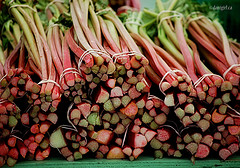
 If you’ve ever enjoyed a piece of rhubarb pie, tart, stew, crumble, or sorbet, you’ve ingested some powerful anti-cancer nutrients.
If you’ve ever enjoyed a piece of rhubarb pie, tart, stew, crumble, or sorbet, you’ve ingested some powerful anti-cancer nutrients.
We’ve heard a lot lately about various fruits and vegetables and their anti-cancer properties. But who ever thought of rhubarb? Apparently, the British.
Researchers at Britain’s Sheffield Hallam University found that baking rhubarb for 20 minutes increased concentration of its powerful phyto-chemicals-which were found to kill or prevent the growth of cancer cells. The study concluded that these chemicals could be used to develop less toxic treatments for the disease, even in cases where cancers had proved resistant to other treatments.
“The main thing we discovered is that rhubarb in Britain has anti-cancer and bioactive components,” said Dr. Gordon McDougall from the Scottish Crop Research Institute. “Our research has shown it is a potential source of pharmacological agents that may be used to develop anti-cancer drugs.”
This isn’t the first time scientists have looked at rhubarb for its health benefits. Anti-tumor effects were found in mice, and lab studies found rhubarb to be toxic to cancer cells. One study found that rhubarb extract decreased toxicity in lungs as a result of radiation treatments, and increased pulmonary function in lung-cancer patients. But overall, studies have been limited, with no practical applications. This British study may be the first step to changing that.
“Current treatments are not effective in all cancers and resistance is a common problem,” Dr. Nikki Jordan-Mahy from Sheffield Hallam University’s Biomedical Research Centre. “Cancer affects one in three individuals in the UK, so it’s very important to discover novel, less toxic treatments, which can overcome resistance.”
Though scientists may be only recently taking a hard look at the benefits of rhubarb, ancient Chinese have used it for centuries. Records dating back to 2700 BC show it was cultivated for medicinal properties. It didn’t appear in America until the early 1800s, when a Maine gardener is said to have obtained the seed or root stock from Europe. A perennial vegetable, the plant isn’t particularly picky and will grow well in most gardens, though it can take five years to become productive.
As to preparation, baking was found to be most effective in drawing out the phyto-chemicals without destroying them-20 minutes being the optimum time. To increase your intake of rhubarb, try it in its simplest form-baked, with a little sugar. Combine about 6 cups cut rhubarb with 1 cup sugar, the zest of one small orange, 3 tablespoons orange juice, and a 2-inch cinnamon stick in a deep, 2-quart casserole. Bake at 400 degrees until the vegetable is tender-from 20–45 minutes. If you want to be more adventurous, check out these other recipes for rhubarb pies, crisps, and crumbles.
Do you have an easy rhubarb recipe? Please share it with us.
Photo courtesy Dani Girl via Flickr.com.

